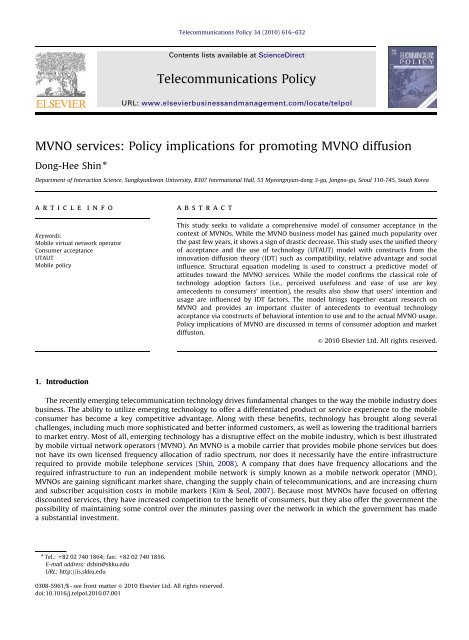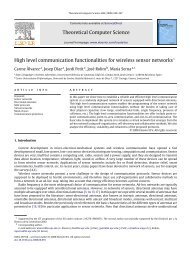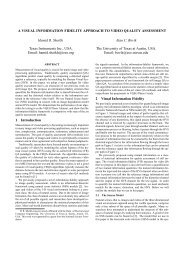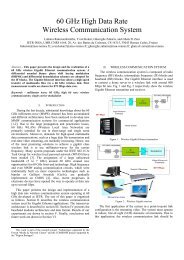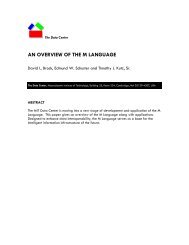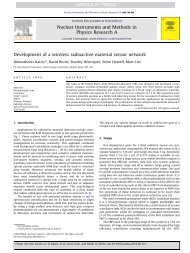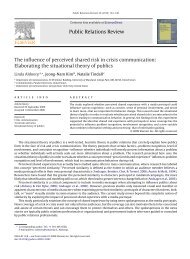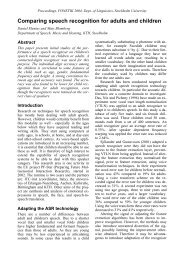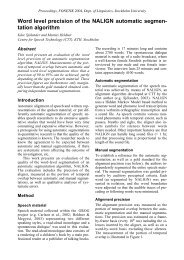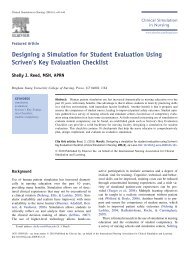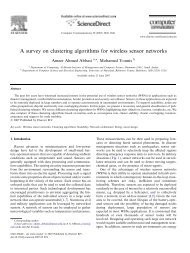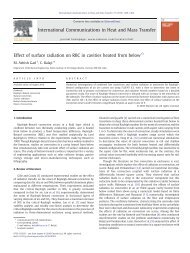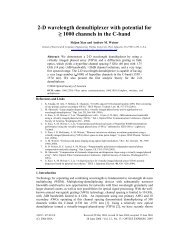MVNO services Policy implications for promoting MVNO diffusion
MVNO services Policy implications for promoting MVNO diffusion
MVNO services Policy implications for promoting MVNO diffusion
Create successful ePaper yourself
Turn your PDF publications into a flip-book with our unique Google optimized e-Paper software.
<strong>MVNO</strong> <strong>services</strong>: <strong>Policy</strong> <strong>implications</strong> <strong>for</strong> <strong>promoting</strong> <strong>MVNO</strong> <strong>diffusion</strong><br />
Dong-Hee Shin n<br />
Department of Interaction Science, Sungkyunkwan University, B307 International Hall, 53 Myeongnyun-dong 3-ga, Jongno-gu, Seoul 110-745, South Korea<br />
article info<br />
Keywords:<br />
Mobile virtual network operator<br />
Consumer acceptance<br />
UTAUT<br />
Mobile policy<br />
1. Introduction<br />
Contents lists available at ScienceDirect<br />
Telecommunications <strong>Policy</strong><br />
URL: www.elsevierbusinessandmanagement.com/locate/telpol<br />
abstract<br />
This study seeks to validate a comprehensive model of consumer acceptance in the<br />
context of <strong>MVNO</strong>s. While the <strong>MVNO</strong> business model has gained much popularity over<br />
the past few years, it shows a sign of drastic decrease. This study uses the unified theory<br />
of acceptance and the use of technology (UTAUT) model with constructs from the<br />
innovation <strong>diffusion</strong> theory (IDT) such as compatibility, relative advantage and social<br />
influence. Structural equation modeling is used to construct a predictive model of<br />
attitudes toward the <strong>MVNO</strong> <strong>services</strong>. While the model confirms the classical role of<br />
technology adoption factors (i.e., perceived usefulness and ease of use are key<br />
antecedents to consumers’ intention), the results also show that users’ intention and<br />
usage are influenced by IDT factors. The model brings together extant research on<br />
<strong>MVNO</strong> and provides an important cluster of antecedents to eventual technology<br />
acceptance via constructs of behavioral intention to use and to the actual <strong>MVNO</strong> usage.<br />
<strong>Policy</strong> <strong>implications</strong> of <strong>MVNO</strong> are discussed in terms of consumer adoption and market<br />
<strong>diffusion</strong>.<br />
& 2010 Elsevier Ltd. All rights reserved.<br />
The recently emerging telecommunication technology drives fundamental changes to the way the mobile industry does<br />
business. The ability to utilize emerging technology to offer a differentiated product or service experience to the mobile<br />
consumer has become a key competitive advantage. Along with these benefits, technology has brought along several<br />
challenges, including much more sophisticated and better in<strong>for</strong>med customers, as well as lowering the traditional barriers<br />
to market entry. Most of all, emerging technology has a disruptive effect on the mobile industry, which is best illustrated<br />
by mobile virtual network operators (<strong>MVNO</strong>). An <strong>MVNO</strong> is a mobile carrier that provides mobile phone <strong>services</strong> but does<br />
not have its own licensed frequency allocation of radio spectrum, nor does it necessarily have the entire infrastructure<br />
required to provide mobile telephone <strong>services</strong> (Shin, 2008). A company that does have frequency allocations and the<br />
required infrastructure to run an independent mobile network is simply known as a mobile network operator (MNO).<br />
<strong>MVNO</strong>s are gaining significant market share, changing the supply chain of telecommunications, and are increasing churn<br />
and subscriber acquisition costs in mobile markets (Kim & Seol, 2007). Because most <strong>MVNO</strong>s have focused on offering<br />
discounted <strong>services</strong>, they have increased competition to the benefit of consumers, but they also offer the government the<br />
possibility of maintaining some control over the minutes passing over the network in which the government has made<br />
a substantial investment.<br />
n<br />
Tel.: +82 02 740 1864; fax: +82 02 740 1856.<br />
E-mail address: dshin@skku.edu<br />
URL: http://is.skku.edu<br />
0308-5961/$ - see front matter & 2010 Elsevier Ltd. All rights reserved.<br />
doi:10.1016/j.telpol.2010.07.001<br />
Telecommunications <strong>Policy</strong> 34 (2010) 616–632
<strong>MVNO</strong>s have been launched in increasing numbers in recent years (Ovum, 2009). Once offering mainly cheap, often<br />
subscriber identity module-based, prepaid voice and short message <strong>services</strong>, <strong>MVNO</strong> offerings now span a wider range of<br />
mobile <strong>services</strong>, including 3G-based content and data <strong>services</strong>. As with many rollouts, however, <strong>MVNO</strong>s have recently<br />
started to lose their momentum showing a clear sign of downfall. The fundamental weakness of the underlying <strong>MVNO</strong><br />
business model is that it only works <strong>for</strong> niches or areas where the network operators are not prepared to venture. The<br />
<strong>MVNO</strong> model has a systemic competitive disadvantage, which is that the underlying operators always have a cost<br />
advantage. The failures of many <strong>MVNO</strong>s were rooted in not offering something that could be had cheaper from the network<br />
operators (Ovum, 2009). Virgin mobile in the UK <strong>for</strong> example leverages the Virgin brand and bundled offerings from other<br />
Virgin group companies, something that cannot be reproduced by other network operators. Other problems have to do<br />
with the technology. <strong>MVNO</strong> providers have struggled over how to personalize phones over the air, as well as how to enable<br />
a better experience <strong>for</strong> using mobile applications via the phone. Another challenge is posed by the many competing<br />
standards; it is necessary to standardize protocols, schemes and <strong>services</strong>.<br />
Among other problems, consumer apathy seems to be the greatest barrier. According to TeleGeography (2008), some<br />
consumers are uncom<strong>for</strong>table with the idea of the <strong>MVNO</strong>—that is, the concern of unstable <strong>services</strong>—and they may be<br />
getting used to having <strong>services</strong> from traditional mobile carriers and may have been affected by network effects (network<br />
externalities) by the dominant incumbent carriers. While there is widespread enthusiasm and hope <strong>for</strong> consumer-oriented<br />
mobile <strong>services</strong>, there are also fears of unstable mobile <strong>services</strong>. <strong>MVNO</strong>s can customize their products to cater to a very<br />
distinct segment of the market, but there is a concern that such customized <strong>services</strong> may not be provided in a stable<br />
manner. The quality of such <strong>services</strong> and content has not yet been confirmed.<br />
Despite concerns over consumer preferences (Ovum, 2009), such issues have been addressed in only a few studies; however,<br />
those few studies focus on the sheer technical aspects of <strong>services</strong> and neglect user dimensions. There is much talk about the<br />
market potential <strong>for</strong> <strong>MVNO</strong> from industry perspectives (particularly economics of MNO, <strong>MVNO</strong> and MVNE), but little robust<br />
customer research from scholarly perspectives. Some academic studies on <strong>MVNO</strong>s have focused on the success factor of <strong>MVNO</strong><br />
business models such as mobile network infrastructure and competition (Cricelli, Grimaldi, & Ghiron, 2009), market structure<br />
(Shin, 2008), government regulations (Lee, Chan-Olmsted, & Ho, 2008), financial perspectives (Varoutas et al., 2002) andthe<br />
relationship between MNO and <strong>MVNO</strong> (Ovum, 2009). However, user preference <strong>for</strong> adopting <strong>MVNO</strong> <strong>services</strong> has not been<br />
thoroughly investigated in past studies. The lack of attention can be ironic in that the key idea of <strong>MVNO</strong>s has been consumerfocused<br />
and customer-directed. The majority of <strong>MVNO</strong>s have been consumer focused and the future success of <strong>MVNO</strong>s will be<br />
determined by how <strong>MVNO</strong>s effectively respond to consumers’ needs. Yet, there remained unanswered questions as to how<br />
consumers feel about <strong>MVNO</strong> <strong>services</strong>, what have been current users’ experiences of the <strong>services</strong> in various contexts and what<br />
will make future consumers engage with such <strong>services</strong>. It may be important to investigate how consumers perceive usability,<br />
how their intentions are <strong>for</strong>med, what cognitive perceptions are fulfilled and what factors influence consumers’ usage behavior.<br />
For these questions, UTAUT is applied to propose a research model that incorporates perceived quality, usefulness, ease of use,<br />
compatibility, relative advantage, switching cost and subjective norm as enhancing constructs to predict users’ motivations <strong>for</strong><br />
adopting <strong>MVNO</strong> <strong>services</strong> over MNO <strong>services</strong>.<br />
With the integrated theoretical framework, this study aims at understanding the user preference <strong>for</strong> adopting <strong>MVNO</strong><br />
<strong>services</strong> in the U.S. market. The <strong>MVNO</strong> market in the U.S. has been one of the largest markets in the world (TeleGeography,<br />
2008). It is expected to generate $22.7 billion in revenues by 2011 (Cricelli et al., 2009). Thus, it is worthwhile to research<br />
the consumer behavior of <strong>MVNO</strong>s in this growing market. Using Structural Equation Modeling as a method of analysis, this<br />
study examines the motivations and intentions of <strong>MVNO</strong> consumers. Although such findings from U.S. consumers may not<br />
generalize to other markets, it offers a set of <strong>implications</strong> that can help telecom researchers and <strong>MVNO</strong>s better understand<br />
how consumers develop perceptions of features and how it contributes to their usage intentions. The findings should be of<br />
interest to both academics and industry concerned with understanding and improving approaches to <strong>services</strong> and<br />
marketing planning. From a theoretical perspective, this study provides a model <strong>for</strong> identifying antecedents of user<br />
intention to adopt an <strong>MVNO</strong> service in reference to UTAUT and the innovation <strong>diffusion</strong> theory (IDT). From a practical<br />
standpoint, the findings should guide an industry <strong>promoting</strong> <strong>MVNO</strong>s in how to develop user dimensions by enhancing<br />
usability and appeal, as well as ensuring quality of <strong>services</strong>. The <strong>MVNO</strong> industry is facing the challenge of how to improve<br />
<strong>MVNO</strong> <strong>services</strong> that are useful, cheap, secure and customized (Lee et al., 2008). However, interface designs and related<br />
elements are rarely examined as qualities in the context of a consumer acceptance perspective. The findings in this study<br />
should be useful <strong>for</strong> the <strong>MVNO</strong> industry to improve their business. Implications and directions <strong>for</strong> future study are also<br />
discussed in the paper.<br />
2. Literature review<br />
2.1. <strong>MVNO</strong> trends<br />
D.-H. Shin / Telecommunications <strong>Policy</strong> 34 (2010) 616–632 617<br />
An <strong>MVNO</strong> is a mobile service operator that does not have its own licensed spectrum and does not have the<br />
infrastructure to provide mobile <strong>services</strong> to its customers (Fig. 1). Instead, <strong>MVNO</strong>s lease wireless capacity from pre-existing<br />
mobile service providers and establish their own brand names different from the providers, that is, they do not own the<br />
network on which their voice and data traffic <strong>services</strong> are carried (Cricelli et al., 2009).
618<br />
Back in the early days of <strong>MVNO</strong>s, a group of researchers predicted <strong>MVNO</strong>s were totally poised to be the next big thing.<br />
Instead, the <strong>MVNO</strong> business model has proven to be disastrous and not so competitive in some markets. The companies,<br />
which buy airtime from providers such as AT&T, Verizon and Bell Canada on a wholesale basis, have disappeared from the<br />
North American wireless scene almost as quickly as these companies appeared. Many researchers started to question the<br />
viability of the <strong>MVNO</strong> model. Cricelli et al. (2009) argue that some <strong>MVNO</strong> models have proven to be a difficult proposition<br />
in the hyper-competitive mobile phone market. Most <strong>MVNO</strong>s seem not to have what it takes to succeed in the wireless<br />
market. New customer acquisition is a game of switching from one carrier to the other. <strong>MVNO</strong>’s will fuel this problem and<br />
drive churn rates even higher. Helio cast doubt on the viability of the business model, when it closed its operation in the<br />
U.S. with a dismal record over less than 2 years. Virgin Mobile has shut down operations in Singapore. Voce, Disney Mobile,<br />
ESPN Mobile and Amp’d Mobile have disappeared from the U.S. market over the past 18 months.<br />
In the case of the U.S., mobile number portability was a significant factor that allowed customers to switch to the new<br />
<strong>MVNO</strong> <strong>services</strong> (Shin & Kim, 2008). In addition, the telecommunication infrastructure was modular and advanced to allow<br />
separation between technical and business aspects of telecommunication <strong>services</strong>. Moreover, during this period the 3 and<br />
3.5 G technologies have become widely available in the U.S., which allowed more <strong>services</strong> to be embedded within mobile<br />
technology, and these <strong>services</strong> became complex enough to make it in the interest of MNOs to outsource some of these<br />
advanced <strong>services</strong> to different operators. In addition, the price of the 3 G license is very high compared to a 2 G license.<br />
Since 3 G <strong>services</strong> had proved to be unattractive in the U.S. to many customers, the MNO started looking <strong>for</strong> alternate<br />
methods to market those <strong>services</strong>. <strong>MVNO</strong>s started to offer discount packages and prepaid payment plans <strong>for</strong> those who<br />
were concerned about their payments.<br />
Although there have been numerous studies on <strong>MVNO</strong>s since their inception (Shin & Bartolacci, 2007; Shin, 2008), few<br />
have attempted to evaluate the <strong>MVNO</strong> consumer dimensions. The overriding perception remains that <strong>MVNO</strong>s have the<br />
potential to disrupt network operators’ businesses. However, the actual customers’ perception and experience have not<br />
been extensively studied. As <strong>MVNO</strong>s have had ups and downs, a rising question is: ‘‘How are consumers accepting <strong>MVNO</strong>s<br />
with what factors?’’ and ‘‘How do consumers perceive the <strong>MVNO</strong> <strong>services</strong> compared to MNO?’’ It may be true that the<br />
<strong>MVNO</strong> is an innovative business model that can provide consumers with great convenience, but are consumers ready to<br />
embrace this innovative but unstable mobile service? What barriers/incentives might reduce/increase the <strong>diffusion</strong> of<br />
<strong>MVNO</strong>s in the consumer market? These are still the elusive questions. This study approaches these questions by analyzing<br />
consumer acceptance behavior.<br />
2.2. The UTAUT model<br />
Radio access/<br />
transmission<br />
Traditional mobile service providing<br />
Mobile network operator<br />
(MNO, ex: Sprint, Cingular etc.)<br />
D.-H. Shin / Telecommunications <strong>Policy</strong> 34 (2010) 616–632<br />
Switching/<br />
network element<br />
Mobile customers<br />
Content/<br />
application<br />
Niche market, customer care, billing, active<br />
marketing & passive marketing<br />
<strong>MVNO</strong> (ex: Page Plus, EZ Link Plus etc.)<br />
Access/transmission/<br />
switching/network functions<br />
(Network carriersm ex: AT&T)<br />
The UTAUT aims at explaining the users’ intention to use technologies and their subsequent usage behavior. The theory<br />
holds that four key constructs (per<strong>for</strong>mance expectancy, ef<strong>for</strong>t expectancy, social influence and facilitating conditions) are<br />
direct determinants of usage intention and behavior (Venkatesh, Morris, Davis, & Davis, 2003). These determinants will be<br />
used to extend the proposed research model. Although the UTAUT originally integrates eight user acceptance models<br />
including IDT, such factors of IDT should be highlighted when considering <strong>MVNO</strong> due to its innovative nature. The<br />
modified UTAUT model will enable a better explanation of <strong>MVNO</strong> acceptance and usage behavior (Table 1). The utility of<br />
the modified model stems from the fact that <strong>MVNO</strong> <strong>services</strong> are heavily technology-driven, as well as consumer-oriented<br />
CRM/<br />
billing<br />
Fig. 1. <strong>MVNO</strong>, MNO and customers.<br />
Marketing/<br />
branding<br />
Sales<br />
channel
Table 1<br />
UTAUT and the adapted model in this study.<br />
UTAUT Adapted model<br />
Per<strong>for</strong>mance expectancy Relative advantage<br />
Perceived usefulness<br />
Ef<strong>for</strong>t expectancy Compatibility<br />
Perceived ease of use<br />
Facilitating condition Switching cost<br />
Perceived quality<br />
Perceived price level<br />
Demographic factors Not considered<br />
Social influence Social influence<br />
Behavioral intention Behavioral intention<br />
Use behavior Use behavior<br />
and niche-focused. Thus, the model is well suited to reflect the nature of <strong>MVNO</strong> because it addresses the evolutionary<br />
progression of technology and usage dynamics toward a more innovative and unpredictable service. In applying this<br />
modified model to a technology-driven environment, the classical technology acceptance model (TAM) variables are<br />
posited as key drivers of <strong>MVNO</strong> adoption, and, in consideration of the UTAUT, the model integrates additional key drivers,<br />
such as switching cost, quality and compatibility. All the key drivers are defined and explained, and their relationship to<br />
transaction intentions and the acceptance of the <strong>MVNO</strong> are examined. Placing these variables under the nomological<br />
structure of the UTAUT and precisely describing their interrelationships integrates them into a coherent and parsimonious<br />
research model (Fig. 2).<br />
3. Hypotheses<br />
Per<strong>for</strong>mance<br />
expectancy<br />
Ef<strong>for</strong>t<br />
expectancy<br />
Social<br />
influence<br />
Facilitating<br />
condition<br />
D.-H. Shin / Telecommunications <strong>Policy</strong> 34 (2010) 616–632 619<br />
Behavioral<br />
Intention<br />
Gender, age, experience, voluntariness of use<br />
Fig. 2. The UTAUT model of Venkatesh et al. (2003).<br />
Use<br />
behavior<br />
This study proposes the adaptation of the UTAUT that incorporates as variables switching cost, social influence,<br />
perceived quality, relative advantage, compatibility, perceived usefulness (PU) and perceived ease of use (PEoU) that<br />
determine behavioral intent, and two constructs influencing usage behavior (behavioral intent and facilitating conditions).<br />
Fig. 3 presents the <strong>MVNO</strong> acceptance/use model proposed here. The acceptance of <strong>MVNO</strong> was evaluated using a UTAUT<br />
model modified from the one originally proposed by Venkatesh et al. (2003). UTAUT has been extensively used to
620<br />
investigate users’ acceptance of mobile <strong>services</strong> (Carlsson, Carlsson, Hyvonen, & Walden, 2007; Liu, Huang, & Chen, 2008;<br />
Wu, Tao, & Yang, 2007).<br />
3.1. Behavioral intention and usage<br />
The UTAUT suggests that a person’s per<strong>for</strong>mance of a specified behavior is determined by his or her behavioral intention<br />
to per<strong>for</strong>m the behavior, and the behavioral intention is jointly determined by the person’s attitudes and subjective norms.<br />
The best predictor of behavior is intention, which is the cognitive representation of a person’s readiness to per<strong>for</strong>m a given<br />
behavior, and it is considered to be the immediate antecedent of behavior. In this study, behavioral intention is a<br />
dependent or endogenous variable, as well as an intermediary variable.<br />
H1. An individual’s intention to use <strong>MVNO</strong>s will have a positive effect on that individual’s usage behavior concerning<br />
<strong>MVNO</strong> <strong>services</strong>.<br />
3.2. PU and PEoU from the TAM<br />
The TAM uses two distinct but interrelated beliefs—perceived usefulness and perceived ease of use—as the basis <strong>for</strong><br />
predicting end-user acceptance of computer technology. In PU, the study highlights the aspect ‘‘capable of being used<br />
advantageously’’ compared with MNO <strong>services</strong>. This study attempts to conceptualize PU in relation to relative advantage;<br />
how consumers perceive <strong>MVNO</strong>s as being useful and advantageous compared with MNO <strong>services</strong>. PEoU refers to the<br />
degree to which a person believes that using a particular system will be ef<strong>for</strong>tless (Davis, 1989).<br />
H2. PU has a positive effect on the behavioral intention of <strong>MVNO</strong> <strong>services</strong>.<br />
H3. PEoU has a positive effect on the behavioral intention of <strong>MVNO</strong> <strong>services</strong>.<br />
3.3. Relative advantage<br />
Relative<br />
advantage<br />
Social<br />
influence<br />
Switching<br />
cost<br />
Perceived<br />
quality<br />
Compatib-<br />
ility<br />
D.-H. Shin / Telecommunications <strong>Policy</strong> 34 (2010) 616–632<br />
H10<br />
H8<br />
H4<br />
-H9<br />
H6<br />
H7<br />
H5<br />
Perceived<br />
usefulness<br />
Relative advantage is defined as the degree to which the innovation is perceived as being better than the alternative it<br />
supersedes (Rogers, 1995). As previous studies have shown, relative advantage and PU are conceptually similar constructs.<br />
Moore and Benbasat (1996) use the PU scales to measure relative advantage. However, there exists an important<br />
distinction between the two. Relative advantage explicitly contains a comparison between the innovation and its<br />
precursor, while this comparison is not an integral part of PU. As such, it may be worthwhile to see how relative advantage<br />
affects PU of <strong>MVNO</strong>. Lopez-Nicholas, Molina-Castillo, and Bouwman (2008) found that relative advantage significantly<br />
H2<br />
Behavioral<br />
Intention<br />
H3<br />
Perceived<br />
ease of use<br />
H1<br />
Fig. 3. Proposed research model of <strong>MVNO</strong>.<br />
H11<br />
Use<br />
behavior<br />
Price<br />
High<br />
Med<br />
Low
affects PU. This study attempts to understand the user’s perceptions of the advantages of the <strong>MVNO</strong> <strong>services</strong> over the MNO<br />
<strong>services</strong>.<br />
H4. Relative advantage of <strong>MVNO</strong> <strong>services</strong> has a positive effect on PU.<br />
H5. Relative advantage of <strong>MVNO</strong> <strong>services</strong> has a positive effect on the behavioral intention of <strong>MVNO</strong> <strong>services</strong>.<br />
3.4. Compatibility<br />
Compatibility is defined as the degree to which an innovation is perceived as being consistent with existing values, past<br />
experiences, and needs of potential adopters (Rogers, 1995, p. 15). Services compatible with existing standards and<br />
technologies are adopted more rapidly than <strong>services</strong> that are not. Shin (2009) found that perceived compatibility<br />
had the strongest effect on behavioral intention among the determinants of mobile banking acceptance. It can be inferred<br />
that making mobile <strong>services</strong> more compatible with potential users’ lifestyles and needs is critical <strong>for</strong> mobile service<br />
providers when <strong>promoting</strong> users’ adoption of the new technologies. In particular, the compatibility and interoperability<br />
of <strong>MVNO</strong> <strong>services</strong> to other mobile <strong>services</strong> (e.g., MNO <strong>services</strong>) can be important factors <strong>for</strong> consumers. For example,<br />
the values of <strong>MVNO</strong> <strong>services</strong> can be increased by SIM cards. This kind of convenience is related to compatibility of<br />
how one service can be compatibly used with other <strong>services</strong> in an interoperable manner. However, at the same time, userperceived<br />
compatibility can be decreased by possible network effects that might exist <strong>for</strong> a set of competing or dominant<br />
carriers with incompatible <strong>services</strong> or standards. The relation (compatibility and PEoU) has been validated by<br />
previous research (Karahanna, Agarwal, & Angst, 2006; Tornatzky & Klein, 1982). Thus, the following hypotheses<br />
can be drawn.<br />
H6. Compatibility has a positive effect on PEoU of <strong>MVNO</strong> <strong>services</strong>.<br />
H7. Compatibility has a positive effect on the behavioral intention of <strong>MVNO</strong> <strong>services</strong>.<br />
3.5. Perceived quality<br />
Service quality is especially important in the context of mobile <strong>services</strong> because consumers become reluctant to use<br />
mobile <strong>services</strong> when they experience frequent delays in response, frequent disconnection, lack of access and poor security<br />
(Aladwani & Palvia, 2002). Lin and Lu (2000) examined in<strong>for</strong>mation quality, response time and system accessibility as<br />
system qualities and showed that these three variables are useful predictors of PEoU and PU. Since response time and<br />
system accessibility, and other factors such as system reliability and security, can be understood as attributes that explain<br />
system quality. Cheong and Park (2005) found positive causal relationships with perceived system quality and PU.<br />
Customers’ perceived quality is particularly important in the adoption of <strong>MVNO</strong> because <strong>MVNO</strong> has targeted providing<br />
quality of <strong>services</strong>. Customers would evaluate quality when they consider adopting new <strong>MVNO</strong> <strong>services</strong> over MNO. On the<br />
basis of these findings, the following hypothesis is proposed:<br />
H8. Perceived quality has a positive effect on the intention to use <strong>MVNO</strong> <strong>services</strong>.<br />
3.6. Switching cost<br />
Perceived switching cost is the degree to which an individual believes that switching service providers would incur<br />
certain cost to him or her (Shin & Kim, 2008). Perceived switching cost rather than actual switching cost explains customer<br />
switching intention and affects the market outcome. Perceived switching costs constructed by carriers can be strategically<br />
used to retain customers, even when customers are less than satisfied with the provider (Lee & Kim, 2004). Because these<br />
costs may vary with customer characteristics and the nature of the product, these costs can be used as attributes <strong>for</strong><br />
market segmentation and targeting. Fornell (1992) distinguishes search, transaction, and learning and emotional costs, as<br />
well as loyal customer discounts, customer habit, cognitive ef<strong>for</strong>t and financial, social, and psychological risks <strong>for</strong> the<br />
consumer as switching costs. For <strong>MVNO</strong> <strong>services</strong>, customers may be less inclined to switch when financial, social and<br />
psychological costs are involved. Thus, switching cost is hypothesized:<br />
H9. Switching cost is related to the customers’ intention to adopt <strong>MVNO</strong>.<br />
3.7. Social influence<br />
D.-H. Shin / Telecommunications <strong>Policy</strong> 34 (2010) 616–632 621<br />
As noted by a number of researchers (Davis, 1989), the contemporary technology acceptance literature is incomplete in<br />
one key respect: it does not account <strong>for</strong> social influence in the adoption and utilization of new technologies. The<br />
importance of normative pressure on intention to use mobile <strong>services</strong> is revealed in studies that are based on system<br />
perspectives. Shin (2007) found that social influence (subjective norm) is a determinant in the unique feature of mobile<br />
Internet via mobile devices. Based on previous studies on social influence, the research model hypothesizes a positive
622<br />
relationship between subjective norm and intention. This is confirmed by recent empirical studies (Shin, 2007), by industry<br />
reports (Ovum, 2009); by a review of the literature (Dahlberg, Mallat, Ondrus, & Zmijewska, 2008); and by theoretical<br />
models such as the theory of reasoned action and the theory of planned behavior (Lucas & Spitler, 2000; Venkatesh et al.,<br />
2003). In particular, <strong>MVNO</strong>s are new <strong>services</strong>, and thus, customers may rely on other people’s opinion and experience in<br />
their adoption decision.<br />
H10. Social influence positively influences customers’ intentions to use <strong>MVNO</strong>s.<br />
3.8. Perceived price level<br />
Perceived price may be a very complicated concept related to monetary cost or price, psychological cost (in psychology<br />
and sociology), cognitive cost (team cognition literature), or social cost (in group/team study and organizational behavior<br />
literature). Incorporating these concepts together, this study defines perceived price as user’s perception of the magnitude<br />
of the costs using an <strong>MVNO</strong> (monetary, stress, and time) that add negative value to users when making a decision. This<br />
definition is similar to that of Teo et al. (2004) and Chen and Thurmaier (2006) who measure price in relation to customers’<br />
perceptions.<br />
H11. Perceived price level negatively influences customers’ usage behavior.<br />
4. Study design<br />
The survey questionnaire was developed through several comment rounds of an expert panel consisting of professors<br />
and researchers, as well as telecommunication experts. Prior to its use, the questionnaire was tested by administering a<br />
pilot survey among possible users, who provided a comprehensive review of individual responses to the pretest survey.<br />
The pilot test analysis consists of a detailed comparison of the data <strong>for</strong> each of the pretest survey participants with other<br />
responses. A pilot test was undertaken to examine test–retest reliability and construct reliability be<strong>for</strong>e conducting the<br />
fieldwork. Twenty students who had had experience with <strong>MVNO</strong>s participated, with tests given at a three-week interval.<br />
The participant group was familiar with <strong>MVNO</strong> <strong>services</strong>, and, prior to answering the questionnaire, they were strictly<br />
instructed to ask the experimenter any questions about the questionnaire items that they did not understand. With these<br />
precautions, the possibility of participants’ filling out some questions without exactly understanding the content of those<br />
questions was eliminated.<br />
The finished survey was administered online. From August to December 2008, a web-based survey questionnaire was<br />
posted on discussion <strong>for</strong>ums devoted to mobile <strong>services</strong>, mobile commerce and mobile games, and on the <strong>for</strong>ums of several<br />
professional associations, and the members of each community were cordially invited to participate. A cover letter was<br />
attached to explain its purpose and to ensure confidentiality. By the time the survey ended, 638 visitors had browsed it,<br />
and 326 questionnaires were submitted. Of the submitted questionnaires, 30 were excluded because of incomplete<br />
answers, leaving 296 usable responses. The web site where the questionnaire was posted had a tracking function showing<br />
how many users had visited the site: 2289 over the 6-month period. A total of 2520 people visited the site and presumably<br />
saw the invitation, but declined to participate (response rate 30.3%).<br />
As the use of the <strong>MVNO</strong> is still an emerging phenomenon, it was important to ensure that the participants had an<br />
appropriate level of exposure to, and experience of, <strong>MVNO</strong> <strong>services</strong> (Chou et al., 2004). Hence, a screening questionnaire<br />
was used to determine whether or not the respondents had had substantial knowledge and experiences with this new<br />
mobile service. It asked respondents about their usage patterns, their frequency of use of various mobile <strong>services</strong>, including<br />
<strong>MVNO</strong>, and their average amount of use. Respondents with substantial experience were invited to the survey. In order to<br />
increase validity and generalizability, the subjects were recruited from various <strong>MVNO</strong> providers, such as Virgin Mobile,<br />
Amp’d, Visage and Mobile ESPN.<br />
Table 2 presents the sample demographics. The final sample is rather unbalanced in terms of age, education and<br />
experience. This may have resulted from the pre-screening procedure that selected users of substantial experiences<br />
with mobile usage. Given the nature of <strong>MVNO</strong>s, however, this unbalance is understandable because a large number<br />
of mobile users are young and educated and able to af<strong>for</strong>d a computer or interested in having one. Thus, the collected<br />
sample in this study reflects the general population of mobile <strong>services</strong>. For the analysis of statistics, AMOS, a maximum<br />
likelihood-based SEM software, was used. AMOS is a covariance-based approach, in which the covariance structure,<br />
derived from the observed data, is used to simultaneously fit the measurement and structural equations specified in<br />
the model.<br />
4.1. Measurement development<br />
D.-H. Shin / Telecommunications <strong>Policy</strong> 34 (2010) 616–632<br />
The participants indicated their agreement with a set of statements, using a 7-point Likert-type scale (ranging from<br />
‘‘strongly disagree’’ to ‘‘strongly agree’’) drawn from previously validated instruments. The measures of PU, PEoU and<br />
behavioral intention were adapted from previous studies relating to the TAM model, mainly from Davis (1989). The<br />
measure used to assess perceived quality was taken from Shin (2009). To measure relative advantage, three items taken
Table 2<br />
Characteristics of respondents (total=296).<br />
Age Number % <strong>MVNO</strong> experience Number %<br />
Under 21 70 23.6 1–3 months 25 8.4<br />
21–30 167 56.4 3–6 months 33 11.1<br />
31–40 49 16.6 6 months–1 year 48 16.2<br />
41–50 9 3.0 1–2 years 126 42.6<br />
Over 50 1 0.3 2–3 years 37 12.5<br />
Over 3 years 27 9.1<br />
Education Number % Gender Number %<br />
High school or lower 41 13.9 Female 128 43.2<br />
College 183 61.8 Male 168 56.8<br />
Graduate or greater 72 24.3<br />
Note: Age=296; Exper=284; Education=298; Gender=303.<br />
Table 3<br />
Discriminant validity.<br />
from Vishwanath and Goldhaber (2007). Social influence was measured with items from Shin (2007). The final scales used<br />
in this study consisted of 27 items, three items per factor.<br />
4.2. Measurement instrument<br />
D.-H. Shin / Telecommunications <strong>Policy</strong> 34 (2010) 616–632 623<br />
Construct Mean SD 1 2 3 4 5 6 7 8 9 10<br />
Perceived quality 4.42 1.18 0.81<br />
Perceived usefulness 4.81 1.28 0.25 0.69<br />
Perceived ease of use 4.25 1.40 0.23 0.18 0.71<br />
Social influence 4.38 1.68 0.14 0.22 0.57 0.82<br />
Switching cost 5.25 0.93 0.17 0.23 0.05 0.21 0.72<br />
Compatibility 4.32 1.09 0.06 0.15 0.14 0.29 0.09 0.81<br />
Relative advantage 4.32 1.21 0.03 0.16 0.08 0.31 0.21 0.03 0.73<br />
Intention 4.80 1.07 0.35 0.14 0.10 0.29 0.28 0.22 0.03 0.82<br />
Usage behavior 4.24 0.91 0.21 0.15 0.18 0.14 0.24 0.34 0.61 0.14 0.68<br />
Perceived price level 4.11 1.34 0.18 0.21 0.31 0.01 0.31 0.11 0.21 0.24 0.31 0.70<br />
Notes: Bold-faced elements on the diagonal represent the square root of the average variance extracted.<br />
The reliability and validity of the measurement instrument were evaluated with SPSS15, using reliability and<br />
convergent validity criteria. The reliability of the survey instrument was established by calculating Cronbach’s alpha to<br />
measure the internal consistency. Each construct was tested <strong>for</strong> reliability and content validity, using Cronbach’s alpha<br />
(Cronbach, 1971). Most of the scores were above the acceptable level, that is, above 0.70. The variables in this study,<br />
derived from the existing literature, exhibited strong content validity.<br />
The convergent and discriminant validity of the model were examined using the procedure suggested by Fornell and<br />
Larcker (1981), who recommend measuring the reliability of each measure and each construct, and the average variance<br />
was extracted (AVE) <strong>for</strong> each construct. The reliability of each item was examined using a principle components factor<br />
analysis. Table 3 shows the results of this analysis, with varimax rotation on the original 26 items (four items were<br />
eliminated due to low loading). According to Hair et al. (1995), a measurement item loads highly if its loading coefficient is<br />
above 0.6. This analysis showed that most items had factor loadings higher than 0.7, which Fornell and Larcker (1981)<br />
consider to be very significant. Each item loaded significantly on its underlying construct (po0.001 in all cases). There<strong>for</strong>e,<br />
all constructs in the model had adequate reliability and convergent validity. To examine discriminant validity, this study<br />
compared the shared variance among constructs with the AVE from the individual constructs. The shared variance<br />
between constructs was lower than the AVE from the individual constructs, confirming discriminant validity (Table 3). In<br />
short, the measurement model demonstrated adequate reliability, convergent validity and discriminant validity.<br />
The wording used in the questionnaire items was similar, so that the responses could be highly inter-correlated.<br />
Possible multi-collinearity problems can be effectively removed by a principal component analysis. In addition, a<br />
correlation analysis of Pearson’s R (a correlation coefficient) shows an acceptable level of correlation among variables<br />
(Table 4).
624<br />
Table 4<br />
Principal component analysis with varimax rotation.<br />
Component 1 2 3 4 5 6 7 8<br />
PQ1 0.773 0.134 0.189 0.299 0.123 0.152 0.239 0.321<br />
PQ2 0.747 0.292 0.232 0.045 0.211 0.134 0.135 0.311<br />
PQ3 0.700 0.219 0.264 0.370 0.233 0.023 0.272 0.011<br />
PEoU1 0.163 0.287 0.243 0.810 0.150 0.151 0.363 0.122<br />
PEoU2 0.262 0.194 0.301 0.751 0.180 0.121 0.116 0.219<br />
PEoU3 0.227 0.224 0.273 0.762 0.190 0.338 0.258 0.293<br />
PU1 0.199 0.329 0.119 0.229 0.253 0.815 0.225 0.299<br />
PU2 0.099 0.263 0.109 0.444 0.629 0.863 0.256 0.189<br />
PU3 0.279 0.192 0.171 0.383 0.240 0.737 0.327 0.173<br />
SI1 0.292 0.231 0.240 0.114 0.796 0.198 0.084 0.134<br />
SI2 0.199 0.192 0.291 0.196 0.790 0.166 0.215 0.211<br />
SI3 0.093 0.201 0.181 0.047 0.729 0.250 0.187 0.321<br />
SC1 0.134 0.189 0.299 0.123 0.152 0.239 0.772 0.199<br />
SC2 0.292 0.232 0.045 0.211 0.134 0.135 0.742 0.109<br />
SC3 0.219 0.264 0.370 0.233 0.023 0.272 0.701 0.264<br />
C1 0.228 0.101 0.715 0.476 0.182 0.206 0.276 0.091<br />
C2 0.193 0.234 0.723 0.326 0.185 0.199 0.326 0.093<br />
C3 0.048 0.305 0.812 0.316 0.240 0.155 0.116 0.392<br />
RA1 0.277 0.741 0.285 0.088 0.180 0.190 0.018 0.323<br />
RA2 0.277 0.758 0.228 0.273 0.182 0.199 0.193 0.194<br />
RA3 0.120 0.811 0.204 0.382 0.249 0.200 0.292 0.193<br />
IT1 0.293 0.178 0.242 0.261 0.130 0.167 0.799 0.093<br />
IT2 0.224 0.283 0.264 0.139 0.212 0.157 0.802 0.119<br />
IT3 0.293 0.218 0.139 0.392 0.251 0.511 0.807 0.281<br />
PL1 0.093 0.201 0.181 0.047 0.229 0.250 0.187 0.621<br />
PL2 0.134 0.189 0.299 0.123 0.152 0.239 0.172 0.799<br />
PL3 0.292 0.232 0.045 0.211 0.134 0.135 0.042 0.609<br />
UB1 0.740 0.199 0.329 0.119 0.229 0.253 0.326 0.110<br />
UB2 0.753 0.099 0.263 0.109 0.444 0.629 0.316 0.213<br />
UB3 0.812 0.279 0.192 0.171 0.383 0.240 0.088 0.119<br />
a-Value 0.8883 0.8961 0.8477 0.8511 0.9101 0.8877 0.8672 0.8333<br />
AVE 0.74 0.69 0.73 0.77 0.72 0.71 0.78 0.79<br />
Note: Numbers in bold show the loading coefficients <strong>for</strong> the items in each construct.<br />
Table 5<br />
Fit indices <strong>for</strong> the measurement model and structural model.<br />
D.-H. Shin / Telecommunications <strong>Policy</strong> 34 (2010) 616–632<br />
Fit statistics Structural model Recommended value<br />
Chi-Square/df 268.352, df=269; p=0.000 –<br />
Normed Chi-Square 1.98 o 5(Bagozzi & Yi, 1988)<br />
AVE – 40.50 (Fornell & Larcker, 1981)<br />
p-Value 0.000 o0.05 (Bentler, 1990)<br />
Goodness of fit index (GFI) 0.95 40.9 (Bagozzi & Yi, 1988)<br />
Adjusted goodness of fit index (AGFI) 0.89 40.8 (Etezadi-Amoli & Farhoomand, 1996)<br />
RMSEA (Root Mean Square Error Approximation) 0.067 4 0.06 (Joreskog & Sorbom, 1996)<br />
4 0.05 (Byrne, 2001)<br />
Standardized RMR 0.027 The smaller the RMR, the better the fit (Byrne, 2001)<br />
TLI (Tucker-Lewis Index) 0.91 Approaches 1 (Byrne, 2001)<br />
4.2.1. Structural model<br />
Structural equation modeling was used to analyze the data. Structural modeling evaluates whether the data fit a<br />
theoretical model. Table 5 shows the estimates from the structural modeling. The overall fit of the model is satisfactory,<br />
with all of the relevant goodness of fit indices greater than 0.90. The GFI is 0.95, the AGFI 0.89 and the TLI 0.91. Similarly,<br />
there is no evidence of misfit, with the RMSEA showing a very satisfactory level of 0.067, which favorably compares to the<br />
benchmarks by Joreskog and Sorbom (1996), who suggest that the values of 0.06 or more reflect close fit. The standardized<br />
RMR was also fairly good, at 0.027, well below the threshold <strong>for</strong> a good overall fit. Another positive test statistic was the<br />
normed chi-square value (a chi-square divided by the degrees of freedom) of 1.98, a value that is appropriately below the<br />
benchmark of three, to indicate good overall model per<strong>for</strong>mance. Given a satisfactory measurement of the model’s fit to<br />
the data, the path coefficients of the structural model were assessed.
5. Results<br />
5.1. Structural paths and hypotheses tests<br />
To test structural relationships, the hypothesized causal paths were estimated. All ten hypotheses were supported with<br />
satisfactory levels of significance (Table 6). The results are reported and depicted in Table 5 and in Fig. 4.Theoverallfitofthe<br />
model is sufficiently good, since the goodness-of-fit statistics are satisfactory and acceptable. The results generally support<br />
the proposed model, illustrating the new dimension of <strong>MVNO</strong> user acceptance. The specified relationship between PU and<br />
relative advantage (H4) was supported by the data, as indicated by a significant critical ratio (CR=3.012). Also, the<br />
relationship between the perceived ease of use and compatibility (H6) was supported by significant critical ratio (CR=3.254).<br />
The CR is a t-value obtained by dividing the estimate of the covariance by its standard error. According to Arbuckle (2005),<br />
CR values larger than 1.96 and 2.32 are statistically significant at 0.05 and 0.01, respectively. Ease of use of <strong>MVNO</strong> <strong>services</strong>,<br />
which is enhanced by compatibility, is related to reaching a higher level of positive intention (H7; CR=3.113). The usefulness<br />
of <strong>MVNO</strong> <strong>services</strong>, which is influenced by relative advantage over MNO <strong>services</strong>, significantly affects intention to adopt<br />
<strong>MVNO</strong> (H2; CR=4.152). Besides PU and PEoU, the switching cost was the strongest determinant of user intention <strong>for</strong> <strong>MVNO</strong><br />
<strong>services</strong> (H9; CR=3.913). The high effect of switching cost is in line with other significant effects (relative advantage and<br />
compatibility). Given the factors are related concepts, we may infer the hidden relations among switching cost, relative<br />
advantage and compatibility. Quality is also a great factor to user intention (H8; CR=2.211). Finally, there is a strong positive<br />
relationship between social influence and intention (H10; CR=2.392).<br />
Fig. 4 displays all the structural relationships among the studied constructs. The figure indicates that the variance in<br />
<strong>MVNO</strong> usage explained by the model is 72 percent, which is fairly high, given that numerous factors may affect acceptance<br />
of, and intention to use, the service. The results show that the variance in individual intentions toward accepting the <strong>MVNO</strong><br />
<strong>services</strong> can be explained by the large proportion of PU and PEoU, along with a large proportion of switching cost. Variance<br />
in behavioral intention to usage behavior of the <strong>MVNO</strong> <strong>services</strong> was explained 40 percent by behavioral intention.<br />
5.2. The effect of price sensitivity on customers’ purchase decisions<br />
As the price variable is shown as a significant factor, it is worthwhile to consider the possible influence of price sensitivity,<br />
that is, how price sensitivity influences customers’ purchase decisions of <strong>MVNO</strong>s. Three levels of price difference<br />
Relative<br />
advantage<br />
Social<br />
influence<br />
Switching<br />
cost<br />
Perceived<br />
quality<br />
Compatib-<br />
ility<br />
*p < 0.05; ** p < 0.01<br />
D.-H. Shin / Telecommunications <strong>Policy</strong> 34 (2010) 616–632 625<br />
2.392*<br />
2.211*<br />
3.012*<br />
-3.913**<br />
2.356*<br />
3.254**<br />
4.013**<br />
Perceived<br />
usefulness<br />
Behavioral<br />
Intention<br />
4.152**<br />
3.113**<br />
Perceived<br />
ease of use<br />
Fig. 4. Result of the research model.<br />
2.122*<br />
Use<br />
behavior<br />
Price<br />
level<br />
2.903*
626<br />
Table 6<br />
A summary of the hypothesis tests.<br />
Hypothesis Standardized coefficient S.E. C.R. Support<br />
H1: Intention-Usage 0.54 0.014 2.122 n<br />
Yes<br />
H2: PU-Intention 0.39 0.103 4.152 Yes<br />
H3: PoEU-Intention 0.22 0.016 3.113 nn<br />
Yes<br />
H4: Relative advantage-PU 0.21 0.091 3.012 Yes<br />
H5: Relative advantage-Intention 0.38 0.459 4.013 Yes<br />
H6: Compatibility-PEoU 0.40 0.218 3.254 Yes<br />
H7: Compatibility-Intention 0.38 0.130 2.356 Yes<br />
H8: Quality-Intention 0.23 0.013 2.211 Yes<br />
H9: Switching cost-Intention 0.42 0.231 3.913 Yes<br />
H10: Social influence-Intention 0.38 0.154 2.392 Yes<br />
H11: Price-Usage 0.53 0.201 2.903 Yes<br />
Notes: S.E. is an estimate of the standard error of the covariance.<br />
C.R. is the critical ratio obtained by dividing the covariance estimate by its standard error.<br />
n Values are critical ratios exceeding 1.96, at the 0.05 level of significance.<br />
nn Values are critical ratios exceeding 2.32, at the 0.01 level of significance.<br />
Table 7<br />
Model selection using AIC and SBC.<br />
Model Price sensitivity AIC SBC<br />
Model 1 Structural model without price sensitivity 498 519<br />
Model 2 Model with higher price 271 289<br />
Model 3 Model with medium price 201 216<br />
Model 4 Model with lower price 133 147<br />
(high, medium and low) are compared. The levels of prices come from <strong>MVNO</strong> prices compared with the price of normal<br />
<strong>services</strong> provided by MNO.<br />
Variable Price sensitivity Comparison<br />
Perceived price level (H) High <strong>MVNO</strong> <strong>services</strong>4MNO <strong>services</strong><br />
Perceived price level (M) Medium <strong>MVNO</strong> <strong>services</strong>=MNO <strong>services</strong><br />
Perceived price level (L) Low <strong>MVNO</strong> <strong>services</strong>oMNO <strong>services</strong><br />
In the price level factor, the three levels of price are given and three models arise. To evaluate and select the model of best<br />
fit, Akaike’s in<strong>for</strong>mation criterion (AIC), a measure of the goodness of fit of an estimated statistical model is used. AIC is a test<br />
between models—a tool <strong>for</strong> model selection. Given a data set, several competing models are ranked according to their AIC,<br />
with the one having the lowest AIC being the best. The chosen model is the one that minimizes the Kullback–Leibler distance<br />
between the model and the truth. It is based on in<strong>for</strong>mation theory, but a heuristic way to think about it is as a criterion that<br />
seeks a model that has a good fit to the truth but few parameters. It is defined as<br />
AIC ¼ 2½lnðlikelihoodÞŠþ2K<br />
where likelihood is the probability of the data given a model and K is the number of free parameters in the model. AIC scores<br />
are often shown as the difference between the best model (smallest AIC) and each other model. Simply put, the smaller the<br />
values of these criteria, the better the generalization of the model. Along with AIC, Schwarz’s Bayesian criterion (SBC) was<br />
per<strong>for</strong>med to verify the selection results. Table 7 shows that the extended model with moderating effects is the best fitting<br />
model, indicating that customers respond to price sensitivity. The model with the lower price variable shows the best fit. This<br />
finding is consistent with the effect of price on <strong>MVNO</strong> <strong>diffusion</strong> (using Logistic, Gompertz, and Bass model) considered in<br />
Section 7 below.<br />
6. Discussion<br />
D.-H. Shin / Telecommunications <strong>Policy</strong> 34 (2010) 616–632<br />
The purpose of the current study was to explain the development of individuals’ behavioral intentions toward, and their<br />
use of, <strong>MVNO</strong> <strong>services</strong>. For this goal, new constructs were adapted from other sources to reflect the features of <strong>MVNO</strong>.<br />
Using the integrated model of UTAUT, this study found that traditional antecedents of behavioral intention, PEoU and PU,<br />
can be linked to IDT-related variables, such as compatibility and relative advantage. The results promise to add to our<br />
understanding of users’ attitudes and intentions in <strong>MVNO</strong>, to clarify <strong>implications</strong> <strong>for</strong> the development of effective <strong>MVNO</strong>
applications and to further produce policy <strong>implications</strong> concerned with the <strong>diffusion</strong> of <strong>MVNO</strong> to increase competition and<br />
promote market dynamics. The results show that the models demonstrate good predictive powers and explain behavioral<br />
intentions toward <strong>MVNO</strong>s.<br />
Consistent with prior research, the results show that PU and PEoU are the two main predictors of intention. Previous<br />
studies and industry reports have shown that usability concerns are the most important factors in considering an <strong>MVNO</strong>.<br />
The present study confirms the importance of actual usefulness and ease of use as well as perceived features, and further<br />
shows that PU and PEoU can be enhanced and moderated by IDT factors including switching cost. These findings together<br />
raise a need to highlight the customer’s subjective viewpoint. As Ovum’s study (2009) shows the perception of <strong>MVNO</strong>s<br />
held by consumers is one major factor <strong>for</strong> the market breakthrough of the system. Although the issue of viability has<br />
emerged as a major inhibitor of <strong>MVNO</strong> acceptance (Shin, 2008), the research on this issue is quite rare to date, especially<br />
from the viewpoint of consumers. The current study approaches the issue from an empirical perspective in order to better<br />
understand the concept of <strong>MVNO</strong> user adoption. The findings shed light on the underlying distinction between the<br />
dimensions of <strong>MVNO</strong> and other mobile <strong>services</strong> provided by MNO. In this study, the consumer subjective norm, based on<br />
social influence, shows a much stronger impact on intention than previous studies of mobile use have indicated (Dahlberg<br />
et al., 2008; Shin, 2009). This suggests that <strong>MVNO</strong> consumers are more influenced by their peers in their decisions to use<br />
than by other mobile application users. Given the immature stage of <strong>MVNO</strong>s, customers may seek a subjective norm, which<br />
increases their intention to adopt and use. The extended model reveals the vital role of social influence in the adoption<br />
process.<br />
The findings in the current study identify a significant role <strong>for</strong> switching cost and its underlying linkage to other<br />
variables—namely, how it is related to intention and how other factors affect switching cost. As antecedent variables, the<br />
roles of switching cost are important, because one of the limitations of the current literature is that it does not help explain<br />
acceptance in ways that guide development, beyond suggesting that each consumer’s psychological burden of switching<br />
has an impact on behavioral intentions and usage behavior. There<strong>for</strong>e, it is essential to understand the antecedents of the<br />
key acceptance variables in order to be able to explain individuals’ switching behavior. This study seeks the answers by<br />
focusing on the actual consumer perspective, how they perceive and interact with <strong>MVNO</strong> and what are the facilitating<br />
factors of consumers having <strong>MVNO</strong> <strong>services</strong>.<br />
The findings in general are in line with previous research on mobile service adoption. Just like the findings in previous<br />
research, consumers’ intentions and usages are much affected by their perception of usability, quality and other facilitating<br />
(compatibility/advantage) and hindering factors (switching cost). The findings go beyond such <strong>implications</strong> in that the<br />
findings imply that <strong>MVNO</strong> consumers perceive quality, usability and service overall differently from other mobile <strong>services</strong>.<br />
Although the new mobile <strong>services</strong> provided by <strong>MVNO</strong>s are of little difference from those provided by MNOs, customers in<br />
reality feel the difference. Specifically, they may expect the <strong>MVNO</strong> <strong>services</strong> to be more customized to the needs of<br />
individuals and more accessible/convenient to use (high-end niche <strong>services</strong> at the same time compatible with generic<br />
mobile service). In this light, the findings in this study can be a guide to designing and developing <strong>MVNO</strong> <strong>services</strong> that<br />
should target specific consumer-oriented preferences. Based on the consumers’ expectation, it can be inferred that <strong>MVNO</strong><br />
<strong>services</strong> would evolve to provide better value and be more innovative. There will be a growing market <strong>for</strong> <strong>MVNO</strong> <strong>services</strong><br />
that strongly attract a niche market. Designing <strong>services</strong> that can appeal to and retain niche consumers requires special<br />
attention and strategies.<br />
Finally, the findings are resonant with the recent telecom industry analyses of <strong>MVNO</strong>s. Industry <strong>for</strong>ecasts predict<br />
<strong>MVNO</strong>s becoming more fragmented with the power of brands and distribution, together with the emergence of new<br />
low-cost aggregators favoring the development of emerging niche markets based on a small social community (Ovum,<br />
2009). The industry <strong>for</strong>ecasts, however, have neglected to notice the importance of the consumer dimension. This study<br />
sought an answer to <strong>MVNO</strong> viability and sustainability from the customers’ point of view. <strong>MVNO</strong> can be more viable and<br />
competitive, but purely competing on technology or a business model cannot be sustained as a long-term strategy if they<br />
neglect to understand consumers. Developing new business models of the <strong>MVNO</strong>s should be heavily based on the<br />
customers’ viewpoints as understanding their preferences would be the key to success.<br />
7. <strong>MVNO</strong> <strong>for</strong>ecasting using <strong>diffusion</strong> model<br />
As the effects of consumers’ perceptions of <strong>MVNO</strong>s are shown to be significant, it is worthwhile investigating the impact<br />
of economic variables such as price and competition. Hwang, Cho, and Long (2009) used <strong>diffusion</strong> <strong>for</strong>ecasting models in<br />
investigating the factors affecting the mobile service <strong>diffusion</strong>. The components of their models include price, competition,<br />
other <strong>services</strong>, and data service. Using their model, this study analyzes how economic factors (in particular price) affect the<br />
<strong>MVNO</strong> <strong>diffusion</strong>:<br />
Diffusion rate ¼ f ðprice,HHI,service,dataÞ<br />
D.-H. Shin / Telecommunications <strong>Policy</strong> 34 (2010) 616–632 627<br />
where HHI is the yearly Herfindahl index of market concentration, service is total cumulative annual mobile subscribers,<br />
and data is the cumulative annual revenue of data-based <strong>services</strong>.
628<br />
7.1. Input data<br />
The data on <strong>MVNO</strong> subscribers during the study period (2000–2009) is the cumulative numbers gathered from annual<br />
reports to the Telecom Associations. One potential concern over the data is that there are only 10 data points. Because<br />
<strong>MVNO</strong>s in the U.S. have only been in existence <strong>for</strong> about a decade, the study period is limited. Yet, because one advantage<br />
of <strong>diffusion</strong> models is that they per<strong>for</strong>m well even with a limited number of data points (Bass, 1969), the availability of 10<br />
observations is appropriate <strong>for</strong> the estimation.<br />
7.2. Estimation<br />
For estimating the model, the methodology used by Hwang et al. (2009) is followed. Their approach is to compare three<br />
models: Logistic, Bass and Gompertz. For the Logistic model,<br />
F ¼ 1=ð1þe ða þ btÞ Þ<br />
where a and b refer to the timing and rate of <strong>diffusion</strong>. For the Bass model,<br />
SðtÞ¼m ðpþqÞ2<br />
p<br />
e<br />
ðp þ qÞt<br />
ð1þðq=pÞe ðp þ qÞt Þ 2<br />
where t=1,2,3,y,T. S(t) is sales in the tth time interval. For the Gompertz model,<br />
F ¼ e<br />
e ðc þ qtÞ<br />
:<br />
Table 8 shows that the coefficient of potential market <strong>for</strong> the Logistic model is 92% with significance. Although the<br />
coefficient of the Gompertz model is 89%, it is insignificant. The estimated number of <strong>MVNO</strong> adopters in the Bass model is<br />
unusually high at 210% of the population, which is considered an error. Thus, the Bass model is deleted from consideration.<br />
7.3. The effect of price on <strong>MVNO</strong> <strong>diffusion</strong><br />
In determining the factors affecting <strong>MVNO</strong> <strong>diffusion</strong>, the Logistic model can be used. In the investigation, the role of the<br />
price variable in consumer adoption and <strong>diffusion</strong> overall can be clarified. To see the effect of price, the variable is added<br />
last in the model. The equation of the Logistic model is<br />
b ¼ b0 þb1 serviceþb2 dataþb3 HHIþb4 price ðb is a function of input variablesÞ<br />
The estimation results are shown in Table 9. They reveal that the contribution of price to the rate of <strong>diffusion</strong> is highly<br />
significant. This result implies that price plays a significant role in accelerating <strong>MVNO</strong> <strong>diffusion</strong> in the U.S. During the<br />
period 2000–2009, the price factor is found to be much more important than service, data and competition.<br />
Table 8<br />
Estimation results.<br />
Parameter Logistic Bass Gompertz<br />
Estimate S.E. t-Stat Estimate S.E. t-Stat Estimate S.E. t-Stat<br />
a 5.234 0.59 9.21 2.103 0.391 12.311 0.1 0.21 0.789<br />
b 0.392 0.014 18.31 0.031 0.01 2.11 0.393 0.031 5.391<br />
s 0.92 0.523 0.00 210.33 134.39 0.211 0.891 1.391 0.681<br />
R 2<br />
0.892 0.913 0.911<br />
Table 9<br />
The estimation result of factors impact on <strong>MVNO</strong> <strong>diffusion</strong>.<br />
Parameter Estimate Standard error t-Statistic p-Value<br />
s 0.73123 0.192313 0.931223 n<br />
a 8.3213 0.234244 13.2133 n<br />
b 0 0.78233 0.029233 1.43922 n<br />
b1, Other <strong>services</strong> 0.19312 0.62342 5.39321 n<br />
b2, Data 0.2123 0.138312 5.32931 n<br />
b3, HHI 29012 0.321231 9.23123 n<br />
b4, Price 0.47492 0.113912 10.3132 n<br />
R 2 =0.99211<br />
n Refers to significance at 99% confidence level.<br />
D.-H. Shin / Telecommunications <strong>Policy</strong> 34 (2010) 616–632<br />
0.000<br />
0.000<br />
0.000<br />
0.001<br />
0.002<br />
0.000<br />
0.000
The lower HHI, the higher is the competition in the mobile market. In Table 9, the value of coefficient b3 is negative,<br />
implying that a decrease in market concentration or a higher level of competition increases the <strong>diffusion</strong> speed of <strong>MVNO</strong><br />
<strong>services</strong>. Other related <strong>services</strong>, as shown in Table 9 (b1 is positive), are complementary to <strong>MVNO</strong> <strong>services</strong>. This is because<br />
as the users of similar <strong>services</strong> increase, the number of customers adopting <strong>MVNO</strong> service also grows. As to data <strong>services</strong>, it<br />
has a negative sign in relation to <strong>MVNO</strong> <strong>diffusion</strong>. This refers to the fact that an increase in data service subscribers <strong>for</strong><br />
voice and other value-added <strong>services</strong> in the market will lead to a decrease <strong>MVNO</strong> <strong>diffusion</strong>, because such value-added<br />
<strong>services</strong> can replace the demand <strong>for</strong> <strong>MVNO</strong> <strong>services</strong>. Conversely, this also implies that <strong>MVNO</strong> <strong>services</strong> will have a<br />
significant market trans<strong>for</strong>mation if the <strong>MVNO</strong> <strong>services</strong> target specialized niche <strong>services</strong>. Overall, the estimations imply<br />
that <strong>MVNO</strong>s may stand out beyond price competition and lead new innovations in the market through plat<strong>for</strong>m<br />
independence, innovative <strong>services</strong>, customer understanding, and content offering.<br />
8. Implications <strong>for</strong> theory and practice<br />
D.-H. Shin / Telecommunications <strong>Policy</strong> 34 (2010) 616–632 629<br />
The results of this study contain several <strong>implications</strong> <strong>for</strong> researchers as well as <strong>for</strong> the mobile industry. This discussion<br />
is related to generalizability of the findings in this study. The practical variables such as switching cost, price, compatibility<br />
and service quality can provide the generalizable consideration to policy implication, whereas theoretical variables such as<br />
perceived usefulness, ease of use, and relative advantage can provide generalizable theoretical results in the technologyadoption<br />
scholarly communities.<br />
The empirical findings demonstrate that highlighting IDT factors would be a worthwhile extension of the UTAUT in the<br />
context of emerging new mobile <strong>services</strong>, as both are found to be influential in predicting the attitude and behavioral<br />
intention to use <strong>MVNO</strong> <strong>services</strong>. Despite the growing interest in the field of <strong>MVNO</strong>s, to date, there has been limited<br />
empirical literature that explor the consumers’ attitudes and intentions toward the <strong>services</strong>. The role that external<br />
variables and intention to use have played in predicting actual usage has received little attention. To fill the gap, this study<br />
investigates the actual usage behavior along with <strong>diffusion</strong> factors and switching cost, rather than just behavioral intention<br />
to use, and this study attempts to identify the factors that determine usage behavior of <strong>MVNO</strong>s. Moreover, the influence of<br />
external variables is examined. A primary contribution of this study is that it highlights the roles of quality and social<br />
influence in the context of a new mobile environment. It is notable that the work contributes to the emerging body of<br />
research by integrating UTAUT and IDT. Traditional antecedents of behavioral intention, PEoU and PU can be linked to<br />
<strong>diffusion</strong>-related variables, such as social influence, relative advantage and compatibility.<br />
Although many studies are presented in an emerging mobile research literature, few have used integrated models or<br />
methods to assess these factors. Prior research on mobile adoption examined the impact of PU and PEoU on intentions <strong>for</strong><br />
mobile <strong>services</strong>, assuming that the perceived features of specific <strong>services</strong> would have an effect on intention to use the<br />
service (i.e., Dahlberg et al., 2008). However, previous studies have neglected to investigate the relationship of PU and PEoU<br />
to other factors of innovation characteristics. The present study indicates that compatibility and relative advantage, as<br />
innovation characteristics, exerts important influences on consumers’ intentions, as well as on their usage behavior<br />
indirectly. In addition, it is worthwhile to see how the mobile-specific factor, switching cost, is related to other variables<br />
including intention. Behavioral intention can be viewed as an individual’s underlying attitude, which ultimately<br />
determines behavioral intentions via attitude (Ajzen, 1991). Thus, this study contributes to the literature on the UTAUT<br />
research by confirming that innovation characteristics from IDT, as salient beliefs, can influence behavioral intention and<br />
usage behavior through PU and PEoU.<br />
The links identified in this study can be a first step toward a synthesized and integrated model of <strong>MVNO</strong>. However,<br />
future studies should further investigate the complex interrelationships among PU, PEoU and social influence to clarify<br />
possible intricate relations. In particular, as the findings show that switching cost can be effectively researched with a<br />
<strong>diffusion</strong> perspective, future studies may further delve into the complicated effects of switching cost on <strong>diffusion</strong>. As Kraft<br />
and Salies (2008) have shown, switching cost can be an important topic of study in terms of <strong>diffusion</strong> and policy<br />
<strong>implications</strong>.<br />
Practical <strong>implications</strong> <strong>for</strong> industry can be drawn from the findings, in terms of strategies and new models <strong>for</strong> <strong>MVNO</strong><br />
<strong>services</strong>. The results of this study can be used by both MNOs and <strong>MVNO</strong>s to better understand markets and to plan their<br />
preferred strategies on whether or not to engage in a relationship. The findings provide useful insight into developing<br />
appropriate marketing strategies to meet customer demands and to further retain and expand a customer base. The finding<br />
that PU and PEoU impact usage behavior through intention indicates that carriers should establish consumer perception of<br />
<strong>MVNO</strong>s by ensuring that their <strong>services</strong> are conducted in accordance with users’ expectations—namely, that their contents<br />
are high quality, <strong>services</strong> are reliable and that promises and commitments are kept.<br />
In conclusion, considering the ever-changing nature of the advanced mobile environment, this study offers help in<br />
understanding phenomena associated with <strong>MVNO</strong>s, and in understanding the <strong>implications</strong> of developing more effective<br />
mobile <strong>services</strong>. As consumers accept the <strong>MVNO</strong> as a new channel of mobile <strong>services</strong>, and as carriers provide enabling<br />
plat<strong>for</strong>ms <strong>for</strong> users, the <strong>MVNO</strong> <strong>services</strong> might become a killer application <strong>for</strong> the next generation of wireless<br />
communication. However, in order to become popular, <strong>MVNO</strong>s have several challenges to overcome, and consumer<br />
acceptance is probably the most important one. Service developers need a better understanding of individual perceptions<br />
concerning the level of security and the influence of social influence on intention to use and return to use. This study
630<br />
provides a basis <strong>for</strong> an evaluative framework to determine the adoption potential of new innovative mobile <strong>services</strong>. The<br />
unified framework in this study can be a good tool <strong>for</strong> understanding market potential by analyzing users’ demands and<br />
prototyping market profiles.<br />
9. <strong>Policy</strong> implication <strong>promoting</strong> <strong>MVNO</strong> <strong>diffusion</strong><br />
D.-H. Shin / Telecommunications <strong>Policy</strong> 34 (2010) 616–632<br />
The findings of this study offer generalizable discussion to policy makers providing the policy implication of <strong>promoting</strong><br />
<strong>MVNO</strong> <strong>diffusion</strong>. Although the models in this study are collective typology, and thus, do not have specific answers, the<br />
structural relations of the factors in the models provide important <strong>implications</strong> <strong>for</strong> telecom policy, which is itself a<br />
combination of numerous factors in the ever-changing telecom ecology. Previous studies (Cricelli et al., 2009; Kim & Seol,<br />
2007; Shin, 2008) have shown various benefits of <strong>MVNO</strong> <strong>diffusion</strong> in telecom markets such as increasing competition,<br />
lowering entry barriers, etc. However, these studies describe the specific economic factors in a limited setting and fail to<br />
provide the overall picture of how the individual factors are structurally related to overall factors in the telecom context.<br />
Given the significant results of this study, policy makers may draw insights from this study on how to promote <strong>MVNO</strong>s in<br />
markets to increase competition and promote public benefits.<br />
First, the finding that switching cost plays a key role in behavioral intention and use behavior provides an important<br />
implication (C.R.= 0.3913 and confounding effects with relative advantage: C.R.=3.039, social influence: C.R.=2.572,<br />
compatibility: C.R.=1.948). <strong>Policy</strong> makers should make ef<strong>for</strong>ts to lower the switching cost in order <strong>for</strong> consumers to more<br />
freely move from MNO to <strong>MVNO</strong>. Currently in the U.S., mobile number portability has been en<strong>for</strong>ced allowing customers to<br />
switch to new mobile <strong>services</strong> including <strong>MVNO</strong>s. When consumers can freely switch from one service to another, there is a<br />
greater struggle to capture consumers. In this perspective, policy should be introduced in order to promote <strong>MVNO</strong>s so that<br />
customers feel a significantly lowered switching cost. In this study, consumers (current and/or prospective) perceive of<br />
switching cost as one of the key factors in their decision of behavioral intention and continuing use behavior. This finding is<br />
supported by Ovum (2009) that switching cost and MNP are significant aspects <strong>for</strong> subscribers to bargain to use <strong>MVNO</strong><br />
<strong>services</strong>. Consumers may feel certain higher barriers or risk than other mobile <strong>services</strong> because most <strong>MVNO</strong>s are smallsized<br />
or new names in telecom markets.<br />
Second, related to the first suggestion, consumers’ discom<strong>for</strong>t and burden of switching may be related to low<br />
compatibility. As mentioned, most <strong>MVNO</strong> <strong>services</strong> are new brands and are provided by small or new carriers in markets, so<br />
consumers may worry about whether or not innovative and cheap <strong>services</strong> provided by <strong>MVNO</strong>s are compatible with other<br />
MNO <strong>services</strong>. At a common sense level, consumers may feel more com<strong>for</strong>table in switching if new <strong>services</strong> of new carriers<br />
are interoperable across different carriers. This interoperability is related to the standardization of mobile <strong>services</strong>. A large<br />
part of current <strong>MVNO</strong> <strong>services</strong> are provided by middleware plat<strong>for</strong>ms of networks, which are provided by network<br />
operators. The middleware software plays a key role in making <strong>MVNO</strong> <strong>services</strong> interoperable with other <strong>services</strong> that are<br />
provided by different networks and different carriers (Ovum, 2009). Although middleware can facilitate making <strong>services</strong><br />
more interoperable and compatible across the industry, policy can make it more effective by en<strong>for</strong>cing an appropriate<br />
standard in mobile <strong>services</strong>. This suggestion can be particularly important because <strong>MVNO</strong>s are targeting very specific<br />
<strong>services</strong> of niche mobile consumers. In this light, Kim and Seol (2007) argue that the viability of launching an <strong>MVNO</strong><br />
depends on the compatibility or applicability of the service offered to the existing host operator’s service offering. In this<br />
line of arguments and the supporting findings in this study, policy makers who wish to promote <strong>MVNO</strong> may consider<br />
adopting a new standardization mechanism <strong>for</strong> <strong>MVNO</strong>.<br />
Third, policy makers may consider adopting a rule of relationship between MNOs and <strong>MVNO</strong>s. The latter have raised a<br />
series of questions as to whether the <strong>MVNO</strong> business model is sustainable without regulatory interference. In the U.S., the<br />
case <strong>for</strong> regulation has traditionally rested on concerns about market power and monopoly leveraging opportunities and<br />
the desire to capture beneficial network externalities (Cricelli et al., 2009). Because competition in the wireless sector has<br />
long been considered robust in the U.S., regulators believe that pro-<strong>MVNO</strong> regulatory intervention is not warranted. Thus,<br />
U.S. regulators seem not to be concerned about anti-competitive leveraging opportunities and <strong>for</strong>bear from imposing most<br />
regulatory constraints on wireless service providers, including pro-<strong>MVNO</strong> intervention. The findings of this study shed<br />
some light on whether <strong>MVNO</strong>s need regulatory protection or if they have sufficient appeal to thrive on their own. The<br />
variables like compatibility, quality and relative advantage can be the positive and sufficient factors <strong>for</strong> <strong>MVNO</strong> to thrive on<br />
their own. On the other hand, switching cost can be the area that needs regulatory protection or intervening mechanism to<br />
promote <strong>MVNO</strong>s (Lee et al., 2008; Shin, 2008). Regarding this, there exists an interesting contrast: <strong>MVNO</strong>s in Western<br />
countries, including the U.S., are competitive enough to battle against MVO without regulatory intervention, while on the<br />
other hand, <strong>MVNO</strong>s in non-Western countries rely on regulation because the MNOs and network operators in such<br />
countries have dominant powers over <strong>MVNO</strong>s. The dominant authorities over infrastructure held by MNOs enable them to<br />
exert clout when negotiating terms and conditions. Thus, <strong>MVNO</strong>s in the region normally have lower quality, less<br />
compatibility, and less useful <strong>services</strong>. MNVOs in such countries should not be left to the players to negotiate on a purely<br />
commercial basis. <strong>MVNO</strong>s in such countries rely on regulatory measures (e.g., lowering switching cost) to compete against<br />
MNOs. The findings in this study imply the need <strong>for</strong> suitable regulatory intervention to assist <strong>MVNO</strong>s, such as establishing<br />
guidelines requiring network operators to lease or to open the networks to <strong>MVNO</strong>s. Such guidelines enable <strong>MVNO</strong>s to offer<br />
quick launches of customized, secure and quality mobile <strong>services</strong>. The regulator should monitor the market, and player
ehavior in the market, to ensure that MNOs conduct negotiations in good faith and fairly, so that the policy objectives of<br />
the <strong>MVNO</strong> decision are fulfilled. If an MNO is engaging in any <strong>for</strong>m of anti-competitive conduct or approaches negotiations<br />
other than on a good-faith basis, it would be in the public interest <strong>for</strong> the regulator to intervene and adjudicate and, if<br />
necessary, make a determination appropriate in each circumstance or case.<br />
Fourth, given the high effects of social influence on intention and usage, governments may enhance public relations and<br />
advertising to increase consumers’ awareness of <strong>MVNO</strong>s and to improve positive notions about <strong>MVNO</strong>s. This study found<br />
that social influence is a significant predictor of intention to use the service. Social pressure represents important<br />
antecedents of consumers’ intentions to use <strong>MVNO</strong>s. It implies that social norm-related influences have significant effects<br />
on the intention to use <strong>MVNO</strong>s. This is even more accurate in an environment like the U.S. where there is a market that<br />
favors high technology and where the consumers are highly sensitive to new trends and rapid shifts in trend and style.<br />
Mobile consumers may be conscious of what other people think about the mobile service asking their opinion and<br />
comparing their behaviors. The <strong>MVNO</strong> consumers may be influenced by word of mouth from other consumers (Ha, Yoon, &<br />
Choi, 2007). A growing number of studies suggest that a normative pressure is the significant factor to explain the rapid<br />
adoption of mobile <strong>services</strong>, and the findings of this study also confirm a positive effect of normative pressures on intention<br />
to use <strong>MVNO</strong>s. This suggests to carriers to consider the social context in which the <strong>MVNO</strong> service is used and the fact that<br />
normative pressures exist <strong>for</strong> various <strong>services</strong>. This also suggests that policy makers need to consider governmental ef<strong>for</strong>ts<br />
to promote public awareness of lowered switching cost, quality and the advantage of <strong>MVNO</strong>s to promote competition in<br />
markets.<br />
10. Limitations and future studies<br />
Several limitations narrow the scope of the above conclusions. First, the findings reflect only limited aspects of<br />
consumer experiences with <strong>MVNO</strong>s. Because <strong>MVNO</strong>s are not yet mainstream phenomena in the U.S. (Shin, 2008), this<br />
research is exploratory, which leads to a limited generalizability. Since this study specifically focused on <strong>MVNO</strong>s, it is hard<br />
to generalize the findings to other generic mobile <strong>services</strong> and other populations. Given that the mobile population<br />
currently runs to over several million, the sample size of 296 may be disproportionate to the whole population of mobile<br />
users. In addition, the research model is only valid <strong>for</strong> the U.S. mobile market due to the difficulty of cross-sectional and<br />
cross-national data collection.<br />
Because <strong>MVNO</strong>s have been in the U.S. market only <strong>for</strong> a few years, data collection was limited. Due to lack of valid data,<br />
this study could not consider more sophisticated models such as incorporating price variation in the SEM. Future studies<br />
should consider these kinds of factors when <strong>MVNO</strong>s become mainstream phenomenon in the markets. Finally future<br />
studies consider adopting generalizability coefficients (Generalizability theory) to the SEM in order to increase<br />
generalizability of the factors identified by this study.<br />
With all these limitations, the remaining question is: To what extent do the findings of this study reflect the actual<br />
customers’ behaviors toward <strong>MVNO</strong>s? Future studies will be able to sample a larger and more typical number of<br />
subscribers. This may be achieved using stratified sampling or a quota sampling method to ensure a certain distribution of<br />
demographic variables. A generalized application of the extended model would require a global data collection process <strong>for</strong><br />
a more thorough validation. In addition, since several intrinsic natures of motivations, such as perceived quality and social<br />
influence, are additional antecedents of intention and usage behavior, it is not possible to generalize the findings to other<br />
mobile applications. For example, since switching cost and perceived price level are subjective matters, all mobile<br />
consumers would claim a burden regarding switching, but there are differing psychological burdens and varying responses<br />
to those burdens. In all, this study took a first step at exploring user experience with <strong>MVNO</strong>s, which have not been<br />
researched well, and found a number of metrics to be reliable and nomologically valid. Despite its several limitations, one<br />
important contribution may be exploring and testing the metrics of consumer behaviors in regard to the emerging <strong>MVNO</strong>s.<br />
In addition to the fact that all the scales used in the study showed high reliability, those of quality, switching cost,<br />
compatibility and relative advantage also demonstrated high nomological validity. There<strong>for</strong>e, future research can use these<br />
metrics with some careful assurance. Testing them against other factors (such as regulatory factors and demographics) will<br />
advance the understanding of <strong>MVNO</strong> adoption and <strong>diffusion</strong> in the next generation mobile era.<br />
Acknowledgments<br />
This research was supported by WCU (World Class University) program through the National Research Foundation of<br />
Korea funded by the Ministry of Education, Science and Technology (Grant No. R31-2008-000-10062-0). This work was<br />
supported by the National Research Foundation of Korea Grant funded by the Korean Government (NRF-2010-B00171).<br />
References<br />
D.-H. Shin / Telecommunications <strong>Policy</strong> 34 (2010) 616–632 631<br />
Ajzen, I. (1991). The theory of planned behavior. Organizational Behavior and Human Decision Processes, 50(2), 179–211.<br />
Aladwani, A., & Palvia, P. (2002). Developing and validating an instrument <strong>for</strong> measuring user-perceived web quality. In<strong>for</strong>mation and Management, 39(6),<br />
467–476.
632<br />
D.-H. Shin / Telecommunications <strong>Policy</strong> 34 (2010) 616–632<br />
Arbuckle, J. L. (2005). Amos TM 6.0 User’s Guide. Chicago, IL: SPSS, Inc.<br />
Bagozzi, R. P., & Yi, Y. (1988). On the evaluation of structural equation models. Journal of the Academy of Marketing Science, 16, 74–94.<br />
Bass, F. M. (1969). A new product growth model <strong>for</strong> consumer durables. Management Science, 15, 215–227.<br />
Bentler, P. M. (1990). Comparative fit indices in structural models. Psychological Bulletin, 107, 238–246.<br />
Byrne, B. M. (2001). Structural equation modeling with AMOS, EQS, and LISREL. International Journal of Testing, 1(1), 55–86.<br />
Carlsson, C., Carlsson, J., Hyvonen, K., & Walden, P. (2007). Adoption of mobile devices/<strong>services</strong>—Searching <strong>for</strong> answers with the UTAUT. In Proceedings of<br />
the 39th annual Hawaii international conference on system sciences. Retrieved from /http://doi.ieeecomputersociety.org/10.1109/HICSS.2006.38S.<br />
Cricelli, L., Grimaldi, M., & Ghiron, N. (2009). Modeling the competition of an HNO versus an <strong>MVNO</strong> in the mobile telecommunications industry.<br />
International Journal of Technology, <strong>Policy</strong> and Management, 9(3), 277–295.<br />
Cronbach, L. J. (1971). Test validation. In R. L. Thorndike (Ed.), Educational Measurement (2nd ed.). Washington, D C: American Council on Education.<br />
Davis, F. (1989). Perceived usefulness, perceived ease of use, and user acceptance of in<strong>for</strong>mation technology. MIS Quarterly, 13(3), 319–340.<br />
Dahlberg, T., Mallat, N., Ondrus, J., & Zmijewska, A. (2008). Past, present and future of mobile payments research, 7(2), 165–181Electronic Commerce Research<br />
and Applications, 7(2), 165–181.<br />
Etezadi-Amoli, J., & Farhoomand, A. F. (1996). A structural model of end user computing satisfaction and user per<strong>for</strong>mance. In<strong>for</strong>mation and Management,<br />
30(2), 65–73.<br />
Fornell, C. (1992). A national satisfaction barometer: The Swedish experience. Journal of Marketing, 56(1), 6–21.<br />
Fornell, C., & Larcker, V. F. (1981). Evaluating structural equation models with unobservable variables and measurement error. Journal of Marketing<br />
Research, 18, 39–50.<br />
Ha, I., Yoon, Y., & Choi, M. (2007). Determinants of adoption of mobile games under mobile broadband wireless access environment. In<strong>for</strong>mation &<br />
Management, 44(3), 276–286.<br />
Hwang, J., Cho, Y., & Long, N. (2009). Investigation of factors affecting the <strong>diffusion</strong> of mobile telephone <strong>services</strong>. Telecommunications <strong>Policy</strong>, 33, 534–543.<br />
Joreskog, K. G., & Sorbom, D. (1996). LISREL 8: Users reference guide. Chicago, IL: Scientific Software International.<br />
Karahanna, E., Agarwal, R., & Angst, C. M. (2006). Reconceptualizing compatibility beliefs in technology acceptance. MIS Quarterly, 30(4), 781–804.<br />
Kim, B., & Seol, S. (2007). Economic analysis of the introduction of the <strong>MVNO</strong> system and its major <strong>implications</strong> <strong>for</strong> optimal policy decisions in Korea.<br />
Telecommunications <strong>Policy</strong>, 31(5), 290–304.<br />
Kraft, J., & Salies, E. (2008). The <strong>diffusion</strong> of ADSL and costs of switching Internet providers in the broadband industry. Research <strong>Policy</strong>, 37(4), 706–719.<br />
Lee, S., Chan-Olmsted, S., & Ho, H. (2008). The emergence of <strong>MVNO</strong>s: An examination of the business strategy in the global <strong>MVNO</strong> market. International<br />
Journal of Media Management, 10(1), 10–21.<br />
Lin, J., & Lu, H. (2000). Towards an understanding of the behavioral intention to use a web site. International Journal of In<strong>for</strong>mation Management, 20,<br />
197–208.<br />
Liu, M., Huang, L., & Chen, A. (2008). Chinese consumer’s adoption intention towards 3G mobile phone. Journal of Mobile Communications, 6(6), 770–786.<br />
Lopez-Nicholas, C., Molina-Castillo, F., & Bouwman, H. (2008). An assessment of advanced mobile <strong>services</strong> acceptance. In<strong>for</strong>mation and Management, 45(6),<br />
359–364.<br />
Lucas, H. C., & Spitler, V. K. (2000). Implementation in a world of workstations and networks. In<strong>for</strong>mation & Management, 38(2), 119–128.<br />
Moore, G. C., & Benbasat, I. (1996). Integrating <strong>diffusion</strong> of innovations and theory of reasoned action models to predict utilization of in<strong>for</strong>mation technology by<br />
end-users. In K. Kautz, & J. Pries-Heje (Eds.), Diffusion and adoption of in<strong>for</strong>mation technology (pp. 132–146). London, England: Chapman & Hall.<br />
Ovum, J. (2009). Virtual mobile <strong>services</strong>: Strategies <strong>for</strong> fixed and mobile operators. London, England: Ovum April.<br />
Rogers, E. M. (1995). Diffusion of innovations (4th ed.). New York, NY: Free Press.<br />
Shin, D. (2007). User acceptance of mobile Internet: Implication <strong>for</strong> convergence technologies. Interacting with Computers, 19(4), 45–59.<br />
Shin, D. (2008). Overlay networks in the West and the East: A techno-economic analysis of mobile virtual network operators. Telecommunication Systems,<br />
37(4), 157–168.<br />
Shin, D. (2009). Towards an understanding of the consumer acceptance of mobile wallet. Computers in Human Behavior, 25(6), 1343–1354.<br />
Shin, D., & Bartolacci, M. (2007). A study of <strong>MVNO</strong> <strong>diffusion</strong> and market structure in the EU, U.S., Hong Kong, and Singapore. Telematics and In<strong>for</strong>matics,<br />
24(2), 86–100.<br />
Shin, D., & Kim, W. (2008). Forecasting customer switching intention in mobile service. Technological Forecasting and Social Change, 75(6), 854–874.<br />
TeleGeography (2008,. <strong>MVNO</strong> Report Packages, August.<br />
Teo, T., Tan, M., & Peck, S. (2004). Adopters and non-adopters of internet stock trading in Singapore. Behaviour & In<strong>for</strong>mation Technology, 23(3), 211–223.<br />
Tornatzky, L. G., & Klein, R. J. (1982). Innovation characteristics and innovation adoption-implementation. IEEE Transactions on Engineering Management,<br />
29, 28–45.<br />
Varoutas, D.A., Katsianis, D., Sphicopoulos, T., Cerboni, A., Kalhagen, K.O., & Stordahl, K., et al. (2002,. 3G <strong>MVNO</strong>s financial perspectives. In Proceeding IST<br />
mobile & wireless telecommunications, summit 2002 (pp. 16–19, 557–561). Retrieved from /http://ssrn.com/abstract=717381S.<br />
Venkatesh, V., Morris, M., Davis, G. B., & Davis, F. D. (2003). User acceptance of in<strong>for</strong>mation technology: Toward a unified view. MIS Quarterly, 3, 425–478.<br />
Vishwanath, A., & Goldhaber, G. (2007). An examination of the factors contributing to adoption decisions among late-diffused technology products. New<br />
Media and Society, 5(4), 547–572.<br />
Wu, Y., Tao, Y., & Yang, P. (2007). Using UTAUT to explore the behavior of 3G mobile communication users. IEEE International Conference on Industrial<br />
Engineering and Engineering Management, 2(4), 199–203.


